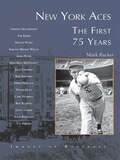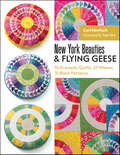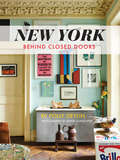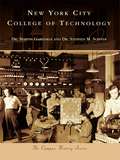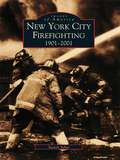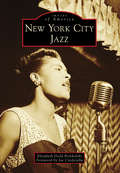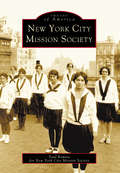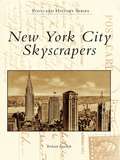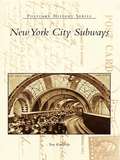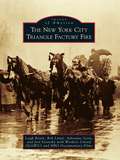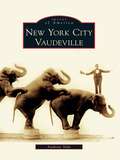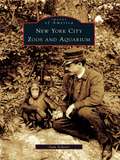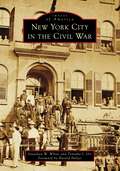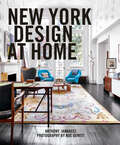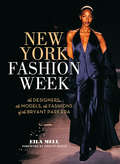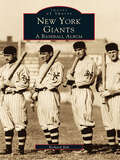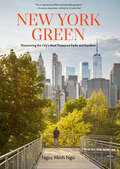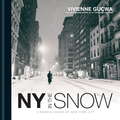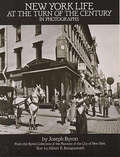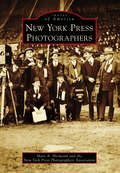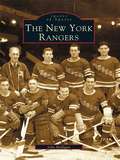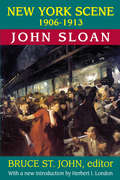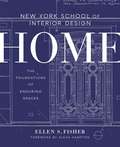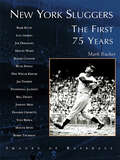- Table View
- List View
New York Aces: The First 75 Years (Images of Baseball)
by Mark RuckerIt was in the New York City area in the mid-nineteenth century that various pitching styles were invented, developments that changed baseball history. In 1883, the Giants became a powerhouse, hiring the finest pitchers in the country. In the twentieth century, the talent pool kept changing, but the quality did not. Christy Mathewson, "Iron Man" McGinnity, and Rube Marquard all won more than two hundred games in the majors, and each played a part in many pennant victories for John McGraw's Giants. In 1921, the Yankees won their first championship, and their domination of the American League that followed was unprecedented. Pitching was both effective and exciting for New York fans, whether in Yankee Stadium or the Polo Grounds. New York Aces: The First 75 Years covers the history of pitching in the Big Apple, with equal attention to the American League and National League franchises.
New York Beauties & Flying Geese: 10 Dramatic Quilts, 27 Pillows, 31 Block Patterns
by Carl HentschDramatic curves and angles for today's adventurous quilter Become a skilled foundation piecer with New York Beauty blocks and arcs of Flying Geese that amaze! Carl Hentsch simplifies a technique loved by many with his straightforward approach to curved piecing, foundation piecing, and simple machine appliqué. Stitch your way through 31 architectural block patterns, ideal for advanced beginners and intermediate quilters. Then it's time to practice on 10 full-size quilts and 27 bonus pillow projects with lively color combinations to provide movement and drama. In a personal foreword, fabric designer Tula Pink discusses how she met Carl and came to collaborate with him on the color choices for his quilts. • Complex piecing made simple! Expand your skill set and learn new tips and techniques for curved and foundation piecing • Traditional blocks shine with the use of modern fabrics in rich color stories, with fabric selections by Tula Pink • Practice your newfound skills on a small project with stunning round pillows designed to accompany each quilt
New York Behind Closed Doors
by Polly DevlinA look inside the homes of New York City&’s artists, designers, writers, and social influencers, including in-depth interviews. These twenty-four homes reflect the tastes and styles of real New Yorkers who live in small spaces with art, books, collections, treasures, and fabulous, sometimes funky furniture—each space expressing the resident&’s unique personality. Bright, captivating photographs throughout pair dynamically with Polly Devlin&’s in-depth interviews with the homeowners. Her critiques of their spaces are at once delightful, bold, and irreverent—and always lively and opinionated. From architectural grandeur to streamlined modern buildings, see how individuals turn older apartments and historic structures into places for comfortable living. Houses and apartments are sampled from across the city, including Tribeca, Murray Hill, Union Square, Harlem, Midtown, Brooklyn, and more. Assembled by a former Vogue editor and a photographer who has worked for House Beautiful, Travel + Leisure, and other major publications, this is a visual and literary feast. &“Showcases some of New York City&’s most unique residential dwellings.&”—Elle Decor
New York City College of Technology
by Dr Martin Garfinkle Dr Stephen SoifferNew York City College of Technology, known today as City Tech, traces its earliest roots to the trade school movement, which was supported by both organized labor and industry. Opening in February 1947 as the New York State Institute of Applied Arts and Sciences, the school served the needs of returning GIs and others in need of employment training. City Tech trained United States Air Force personnel in its employment-oriented programs, including the first college-based program in the country in restorative dentistry. City Tech became the first public community college in New York, and in 1981, it became the senior college of technology of The City University of New York. Today City Tech is the largest public college of technology in the Northeast and the most diverse. New York City College of Technology highlights the history of this vibrant institution that has continually served the needs of both its students and its city.
New York City Firefighting: 1901-2001 (Images of America)
by Steven ScherThe story of firefighting in New York City is one of danger, tradition, pride, excitement, and tragedy. It is also the story of man's triumph over destructive forces. From the gaslight days of horse-drawn steam engines to the World Trade Center tragedy of 2001, the heroic men and women who make up the city's most dynamic public service have risked and often lost their lives in order to protect and serve the people of New York City.New York City Firefighting: 1901-2001 chronicles the proudest fire department in America. The proximity of buildings in the city streets and the construction materials made each fire especially dangerous, but determined firefighters never hesitated to battle the flames and rescue the victims. Later, facing unprecedented heights and unparalleled danger, firefighters in New York City were called upon to battle infernos in the first skyscrapers, often using the most rudimentary equipment and barely protected from the flames. In its most trying moments, the Fire Department of New York responded to the terrorist attacks on the World Trade Center in 1993 and 2001, dutifully rushing into the towers to save as many lives as possible and ultimately losing hundreds of their own.
New York City Jazz
by Elizabeth Dodd Brinkofski Joe CinderellaNew York City Jazz explores many of the haunts and hideaways that have played host to iconic jazz musicians and singers like Charlie Parker, Miles Davis, John Coltrane, Bill Evans, Billie Holiday, Dizzy Gillespie, and Lester Young. Considered the jazz capital of the world, New York City is known for its flashy venues. The stages of the Latin Quarter, Apollo Theater, Minton's Playhouse, Onyx, Stork Club, Downbeat Club, Birdland, Roseland, and Copacabana came to life with the sounds of pianos, drums, horns, and gypsy guitars. This collection of images presents why Fifty-second Street was nicknamed "Swing Street" and how musicians made timeless names for themselves in the Empire City.
New York City Mission Society
by New York City Mission SocietyEstablished in 1812, New York City Mission Society is one of the nation's oldest private social services organizations. During its long history, Mission Society has established a reputation for innovative, needs-responsive programming. Its board, staff, and programs helped launch such well-known organizations as the Community Service Society and the Fresh Air Fund. Mission Society also developed New York City's first visiting nurse service, first branch libraries in communities of need, and first sleep-away camp for African American children. Today, it remains one of the most respected social service organizations in New York City, improving the quality of life for thousands of children and families each year.New York City Mission Society captures the richness of the organization's history and the spirit of charity that has defined its work since the beginning. The images and accompanying captions explore the various individuals, programs, and services that have distinguished Mission Society in the hearts and minds of New Yorkers for nearly two hundred years. Highlights include photographs of early Mission Society leaders such as William Earl Dodge and Lucy S. Bainbridge, President Harry S. Truman's 1948 letter congratulating the organization on its one hundred twenty-fifth anniversary, and vintage views of programs like the City Mission Cadet Corp and Camp Minisink.
New York City Skyscrapers
by Richard PanchykNew York City Skyscrapers celebrates the numerous awe-inspiring buildings that have made New York the skyscraper capital of the world. This book traces the history of New York's tallest structures from the late 19th century, when church spires ruled the skyline, through the 20th century, when a succession of amazing buildings soared to new heights. From the Flatiron and Woolworth Buildings to the Chrysler and Empire State Buildings, the skyscrapers of New York have long captured the imagination of people around the world.
New York City Subways (Postcard History Series)
by Tom Range Sr.New York City Subways traces the history of mass transportation in Manhattan and New York City's outer boroughs. Public transportation has long been vital to the city, with horse-drawn surface lines established by 1831 and elevated railroad lines constructed during the 1870s and 1880s. The concept of subways, railroads operating underground, originated in London in 1863 and was applied to New York City by 1904. This collection of vintage postcards brings you through the tunnels of the subway, onto the platforms of the long-gone els, and examines New York's renowned terminals, especially Grand Central and Penn Station.
New York City Triangle Factory Fire, The
by Joel Sosinsky Adrienne Sosin Rob Linné Leigh BeninOn March 25, 1911, flames rapidly consumed everything within the Triangle Waist Company factory, killing 146 workers. The victims, mostly young Jewish and Italian immigrant women, died needlessly due to unsafe working conditions, such as locked or blocked doors, narrow stairways, faulty fire escapes, and a lack of sprinklers. Until September 11, 2001, the Triangle fire was the deadliest workplace disaster in New York City history. Mass grief and outrage spread from New York's Lower East Side across the country. Garment union membership swelled, and New York politics shifted dramatically toward reform, paving the way for the New Deal and, ultimately, the workplace standards expected today. Through historic images, The New York City Triangle Factory Fire honors the victims' sacrifice and serves as a reminder of the ongoing struggle for the dignity of all working people.
New York City Vaudeville
by Anthony SlideNew York City Vaudeville provides a unique pictorial record of America's preeminent entertainment medium in the late 1800s through the early 1930s. New York's Palace Theatreserved as the flagship for vaudeville, on which stage everyvaudevillian aspired to perform. New York City Vaudevillefeatures photographs of some of the greatest names fromthe Palace Theatre, including Jack Benny, George Burnsand Gracie Allen, Anna Held, the Marx Brothers, and Eva Tanguay, as well as legendary African American performers such as Bill Robinson, Ethel Waters, and Bert Williams. Through the photographs and the capsule biographies, the reader is transported back to a time when vaudeville was the people's entertainment, with a new bill of fare each week and an ever-changing number of performers with ever-changing styles of presentation.
New York City Zoos and Aquarium (Images of America)
by Joan ScheierSituated within the five boroughs of New York City are five zoos and one aquarium. New York City Zoos and Aquarium chronicles the establishment of the Central Park Zoo, the Bronx Zoo, the Prospect Park Zoo, the Queens Zoo, the Staten Island Zoo, and the New York Aquarium. Popular children's zoos are also featured. The city's first zoo opened in Central Park in the 1850s, while the newest zoo opened in Queens after the 1964 World's Fair. While each one of these facilities has many similarities, they all have their own unique attributes. All of the facilities are focused on education, conservation, and the care of the animals that now reside in natural habitats.
New York City in the Civil War (Images of America)
by Jonathan W. WhiteNew York City was the center of business, commerce, manufacturing, culture, and war spirit in the North during the Civil War. Abraham Lincoln gained an important national audience at the Cooper Institute in February 1860. Tens of thousands of young men enlisted in the city and marched off to fight. Factories churned out materiel for the soldiers. Black leaders such as Frederick Douglass mobilized African American support for the Union. Foreign dignitaries were the subject of grand celebrations on Broadway. Immigrants raised celebrated ethnic regiments, and nationally renowned newspapers debated the pressing issues of the day. In short, the city was a vital engine that powered Union efforts. Yet New York was also a divided metropolis where political differences were hashed out—sometimes violently. The deadliest urban racial violence in American history took place in Manhattan in July 1863. In this book, New Yorkers regain their place at the center of the Union war effort on both the battlefield and the home front.Acclaimed historians Jonathan W. White and Timothy J. Orr bring New York City’s Civil War story to life through photographs and illustrations drawn from libraries, archives, and private collections around the United States. Foreword author Harold Holzer is the Jonathan F. Fanton Director of the Roosevelt House Public Policy Institute at Hunter College and a leading historian of Lincoln and the Civil War in New York City.
New York Design at Home
by Anthony IannacciA photographic tour through designers’ own spaces, from a Greenwich Village town home to a Park Slope brownstone and beyond.Designers’ homes often serve as laboratories where they are free to experiment. These spaces are filled with the designer’s most personal and cherished objects, furnishings, and artwork that are concentrated expressions of their style and interests. New York Design at Home profiles 27 homes and looks at how these creative professionals—among them David Gresham, Ellen Hanson, Benjamin Pardo, Ariel Ashe, and many more—approach design in their personal space. Like most New York City residents, they are decorating with much smaller budgets than they have on their work projects, but they find creative ways to deal with tiny bathrooms, awkward and unusable kitchens, and shared living spaces. Photographed by Noe DeWitt, New York Design at Home highlights the carefully considered details within each interior—the Pablo Picasso painting reproduced as wallpaper, the kitchen utensils on display, textiles that provide pops of color in an otherwise monochromatic space—and captures the creative essence of these homes with new, never-before-published images.
New York Fashion Week: The Designers, the Models, the Fashions of the Bryant Park Era
by Eila MellSince 1993, Bryant Park has been the event’s home, but in 2010 relocated to Lincoln Center. New York Fashion Weekfocuses on what’s already been termed the "Golden Era” of Fashion Week, the Bryant Park Years. It is filled with hundreds of never-before-seen photos and never-before-told stories and features exclusive interviews with the likes of Tommy Hilfiger, Betsy Johnson, Richie Rich, The Blonds, Andre Leon Talley, Philip Bloch, Fern Mallis, and many more. Capturing the most exciting moments, trends, and people from seventeen years under the tents of Bryant Park,New York Fashion Weekgives industry professionals, style savvy consumers, and pop culture and celebrity fans an essential piece of fashion history.
New York Giants: A Baseball Album (Images of Sports)
by Richard BakThe New York Giants have sent more men to the Baseball Hall of Fame than any other team, a distinction that only begins to hint at the place this storied franchise holds in the long history of America's national pastime. Between 1883 and 1957, a span of 75 summers, the Giants were one of professional sports' great dynasties. Aside from the17 National League pennants and 8 world pennants the team won during this period, there were the unique personalities and imperishable moments that remain so much a part of the lore of the game: John McGraw's pugnacity, Christy Mathewson's fadeaway, Fred Snodgrass's muff, Mel Ott's leg kick, CarlHubbell's scroogie, Bobby Thomson's home run, and Willie Mays' catch. Even the Giants' ballpark, the Polo Grounds, had a personality of its own, with a center field that seemed as expansive as Utah and abbreviated foul lines that turned many an ordinary fly ball into a mighty home run.
New York Green: Discovering the City's Most Treasured Parks and Gardens
by Ngoc Minh NgoThis beautifully photographed guidebook celebrates New York City&’s most exceptional—and often overlooked—parks and gardens, all open to the public! New York City is filled to the brim with beautiful, unique green spaces—if you know where to look. From the Church of St. Luke in the Fields in the West Village to the Brooklyn Grange rooftop farm in the Navy Yard, the Isamu Noguchi Foundation and Garden Museum in Queens to New York&’s Chinese Scholar&’s Garden in Staten Island, celebrated photographer Ngoc Minh Ngo takes readers on a tour of the most exceptional gardens and parks across the five boroughs in this lushly illustrated guidebook. Through Ngoc&’s beautifully photographed and well-researched profiles, readers will not only discover parks and gardens they never knew existed, but they will also learn the fascinating history of green spaces in New York and about the innovative new projects being undertaken to ensure we all can enjoy them for years to come. Head up to the nearly century-old Met Cloisters to discover a garden filled with plants depicted in the museum&’s medieval art collection, and an herb garden planted exclusively with species known in the Middle Ages. Then travel to Brooklyn to visit the Gil Hodges Community Garden, a tiny oasis along the Gowanus Canal and a critical piece of the city&’s green infrastructure: storm water is absorbed, filtered, and diverted to the garden, relieving pressure on the sewer system and thereby protecting the local waterways from contamination. The book features wildlife preserves and community vegetable patches, sprawling old-growth forests and vest-pocket parks of less than five thousand square feet. Each one tells a story, and offers a wonderful refuge from the hustle and bustle of the concrete jungle.
New York In The Snow
by Vivienne GucwaThe iconic city of New York is a bustling, heady metropolis that, thanks to the power of media, everyone in the world knows intimately, even if they've never been. But every once in a while it changes completely. At first a few flakes will fall, then more, and more. Hardened New Yorkers rush for warmth and, while they're absent, an amazing, glistening almost deserted winter wonderland momentarily appears.It is these moments that phenomenally popular photo-blogger Vivienne Gucwa lives for. She has been documenting them for more than a decade, rushing out to capture the city in snow. Of all the photos that have made her the celebrated, award-winning success that she is, it is these that are most loved, both online and in print, so we offer them here in a sumptous volume to be enjoyed by anyone who loves New York, whether from afar, as an occasional visitor, or if you've never left the Big Apple.
New York In The Snow
by Vivienne GucwaThe iconic city of New York is a bustling, heady metropolis that, thanks to the power of media, everyone in the world knows intimately, even if they've never been. But every once in a while it changes completely. At first a few flakes will fall, then more, and more. Hardened New Yorkers rush for warmth and, while they're absent, an amazing, glistening almost deserted winter wonderland momentarily appears.It is these moments that phenomenally popular photo-blogger Vivienne Gucwa lives for. She has been documenting them for more than a decade, rushing out to capture the city in snow. Of all the photos that have made her the celebrated, award-winning success that she is, it is these that are most loved, both online and in print, so we offer them here in a sumptous volume to be enjoyed by anyone who loves New York, whether from afar, as an occasional visitor, or if you've never left the Big Apple.
New York Life at the Turn of the Century in Photographs (New York City)
by Joseph ByronHere are 120 wonderful vintage views from the collection of the Museum of the City of New York. Remarkable for clarity, definition and detail, the prints comprise a richly evocative portrait of turn-of-the-century life -- street scenes, parks, restaurants, commercial interiors, Easter Parade, Blizzard of '99, Coney Island, a dinner for Mark Twain, etc. Informative text.
New York Press Photographers
by Marc A. Hermann New York Press Photographers AssociationNew York City has earned its place as the media capital of the world, and its newspapers have chronicled life, death, triumph, and tragedy. While people like Damon Runyon, Walter Winchell, and Jimmy Breslin are remembered for how they wrote about the news, the people who documented it visually are mostly forgotten. For many decades, photographers who captured iconic images for New York's newspapers did so anonymously--picture credit lines were a rarity. This is the story of the people behind the pictures, a history of the historians. In 1915, a group of lensmen formed a fraternal organization to promote their craft and support one another through hardship. A century later, the New York Press Photographers Association (NYPPA) is regarded as the oldest press association in America, and it still advocates for its members in an ever-changing field. At work or at play, New York's photojournalists are hardly the nameless, faceless bunch history would have us believe them to be.
New York Rangers, The (Images of Sports)
by John HalliganFor more than three quarters of a century, the New York Rangers have been delighting hockey fans-New Yorkers and suburbanites alike-with a classy brand of entertainment that has no equal. The team's history includes four Stanley Cups, scores of individual stars, and countless magic moments. All of the excitement and drama of these triumphs is captured in The New York Rangers. This book salutes not only the Rangers' tradition of excellence but also the masterful talents of the photojournalists who have chronicled the team since its birth in 1926.
New York Scene: 1906-1913 John Sloan
by John Sloan Bruce St. John Herbert I. LondonOne of "The Eight"—a major group in the history of American painting—John Sloan was also an illustrator and cartoonist. Sloan kept an almost daily diary for eight years, for the most part to entertain his first wife, Dolly. Sloan's second wife and widow, Helen Fan Sloan, turned over the diaries and his letters, as well as notes and drawings to Bruce St. John of the Delaware Art Center, which houses the Sloan collection.John Sloan was interested in every social issue that went on around him: the people across the street, the people in the parks, and the policies of his country. He and Dolly entertained almost every night, though they were so poor that often the only dish was spaghetti, and their guests included Robert Henri (Sloan's mentor) and Walt Kuhn, Walter Pach, Rollin Kirby, Stuart Davis (and his father), Alexander Calder (and his father), Rockwell Kent, John Butler Yeats, William Glackens, and George Luks.Even if John Sloan had not been such an important figure in the American art world, these diaries would be splendid reading: they reveal a perceptive man and the city that fascinated him during one of its most interesting epochs. The editor writes that Sloan "was a direct and honest man, not afraid of expressing his opinions." This fascinating, unique, first-person view of New York City is a masterpiece. This edition includes a new introduction by Herbert I. London, providing insight into the social and political vision that animated Sloan's art.
New York School of Interior Design: The Foundations of Enduring Spaces
by Alexa Hampton Ellen S. Fisher Jen RenziFrom the nation's top college for interior design comes a definitive design school in a book and a fabulous reference for decorating the home. In the past decade, New York School of Interior Design, which was founded in 1916, has drawn a large crossover audience of passionate decorating enthusiasts and hobbyists--many of them private homeowners who know that thinking like a professional is the surest way to achieve a magnificent home. This lavishly illustrated and highly detailed interior design bible provides a comprehensive education on home design and decor, from color theory principles to space-specific considerations (choosing furniture for a living room) and collaborating with architects and other professionals for the best results. Built on the Home Study Course that is the foundation of the school's curriculum, this book offers an unparalleled mastery of the key elements of enduring design, rendering it the only book you'll ever need.From the Hardcover edition.
New York Sluggers: The First 75 Years (Images of Baseball)
by Mark RuckerNew York City was the original hotbed of baseball, so it is not surprising that fans in the five boroughs are very knowledgeable about the game. It did not take long after baseball was established in the city in the late 1850s for heavy hitters to rise in popularity. New York has continued to set the standard. When thinking about hitting, or better yet, smashing or crushing a baseball, the first team to come to mind is always the New York Yankees. Slugging was actually invented by the Yanks and was most prominently demonstrated by Babe Ruth. When Lou Gehrig joined the team in 1923, a one-two punch was established that set a standard seldom equaled in major-league history. Meanwhile, across the East River, the Giants manufactured lots of hitting, and the New York Nationals rattled the walls in the Polo Grounds. This book is a pictorial story of the sluggers that made history in New York, in both the American and National Leagues.
